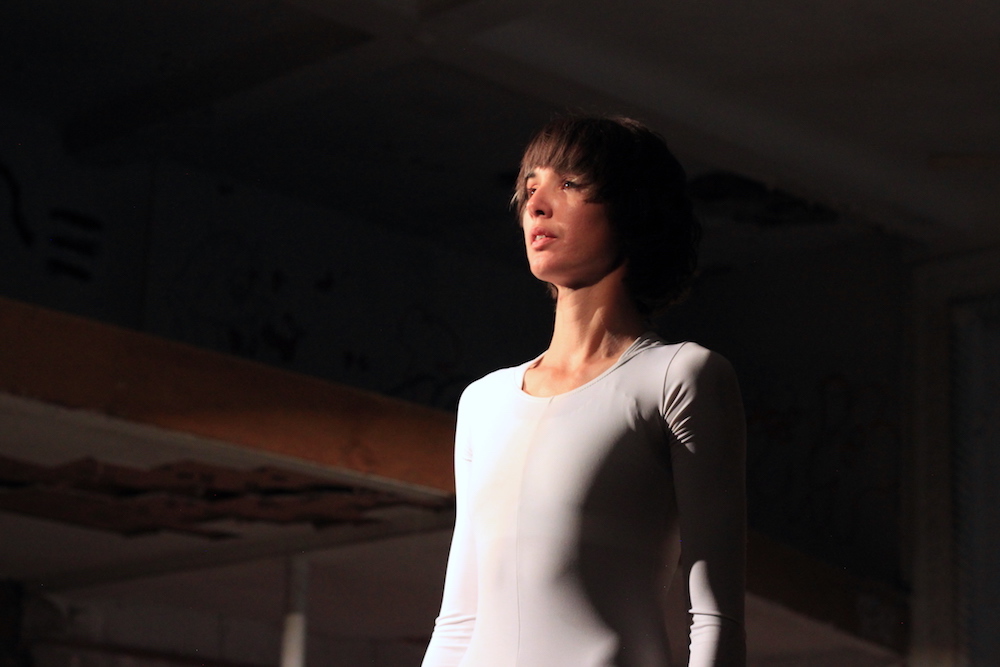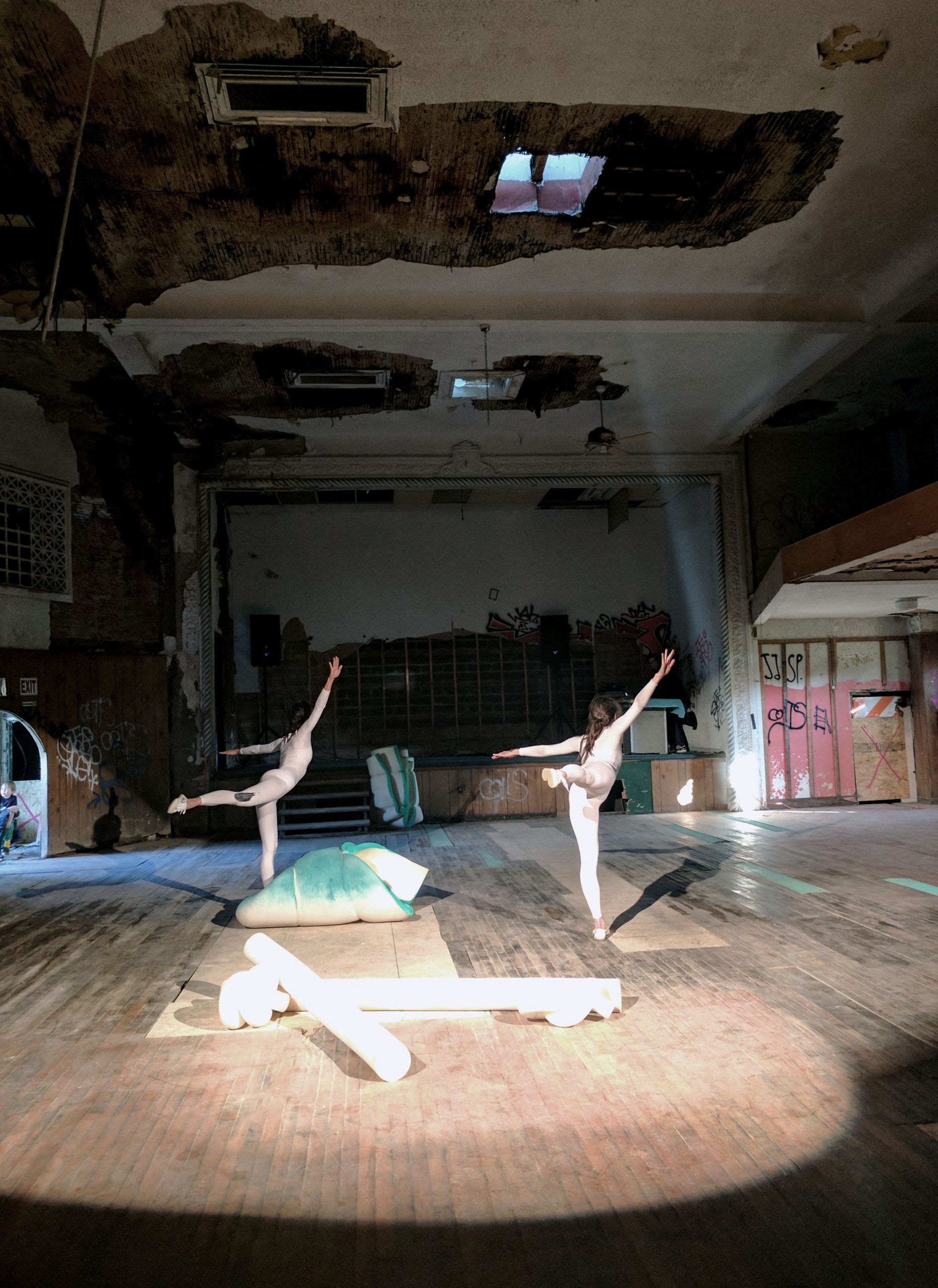Biba Bell + Jessie Gold’s Post-Industrial-Rave Dance in Detroit
It had rained earlier in the day, but by 5pm the sky was soft and bright, the late afternoon sun lighting up the green lawns of Detroit’s East Side Historic Cemetery. Across the street, cars were parallel parked outside of a nondescript aquamarine building, immediately revealing years of neglect under a fresh coat of paint. I joined a stream of people starting to trickle in through the front entrance of the roofless structure. We were arriving for Body Factory, a dance collaboration between Biba Bell and Jessie Gold, but the ballet of bodies began before we witnessed limbs in leotards under spotlights. The audience was choreographed too, gently guided through a garden party and a bus ride, before arriving at a second fixed-up-abandoned building where the more legible contemporary dance performance took place. “It’s like a dance inside a dance,” Bell explained.

Arriving at the second space, dancer-choreographers Bell and Gold greeted us in matching loose black dresses, one with a big white semi-colon on the front, the other an exclamation point. They repeated a simple gesture outlining two rectangles on the floor with a brisk stride. Later, it became clear that they were marking the perimeter of the “stage,” directing the audience where they should organize to stand or sit on the raw wood floor for the duration of the performance. “We asked them to figure it out,” recalled Gold, later adding, “We asked a lot from the audience without them knowing it.”
The end of this gesture was signaled by the close of the song being played by Bell and Gold’s collaborator Ivan Berko, perched like a DJ behind a table of electronic equipment on a small raised stage behind the dancers performing live to the soundtrack he’d composed. With this cue, the two women went to either side of the room to take off their black dresses, revealing identical long-sleeved white leotards underneath them. Like a series of nesting dolls, now the dance inside the dance inside the dance was beginning, with Bell and Gold performing a succession of sequences that referenced a movement vocabulary of American postmodern dance, specifically the levity of Merce Cunningham and the rigor and geometry of Trisha Brown.
Body Factory marks the first choreographic collaboration between Bell, a Detroit-based dancer, choreographer, and professor at Wayne State University, and Gold, a Miami-born, New York-based dancer and choreographer currently touring with artist Maria Hassabi. “In terms of choreography,” Gold recalls, “I’m not even sure we had much of a conversation, except we are going to put this dance in this space.” Bell adds that the specific techniques they were working with are something that their bodies just generate when they are together because of a shared history. “When Jessie and I met,” she recounts, “we were both fresh. I had just moved to New York in ’98 or ’99 and we were taking classes together at a Cunningham studio and a Brown studio. Even though we’ve worked with a bunch of different artists since then, we have that reference together.”

Another reference for Bell and Gold was 1990s Detroit techno and rave culture, which played out in a “post-industry context.” They paralleled their activation of these abandoned spaces as akin to the way parties energized the city’s derelict buildings. The iconic Packard Plant, the sprawling automobile-manufacturing factory built at the turn of the century and left abandoned by the 1990s, was the site of the most legendary raves of that era. “Basically you’re looking at the fallout of capitalism and these factory spaces being filled with bodies and ecstatic movements,” explained Bell.
The pair also wanted to simulate the experience of tracking down an underground venue that was commonplace before a promoter could just DM you the address, when there was often a multi-step process of going to one location and meeting someone who would give you a clue or a second address. “There was a camaraderie that came with finding the space itself,” Gold affirmed, which they aimed to replicate with their own multi-step process. “The audience has this experience before they even get to the performance.”

Bell and Gold guided us through the piece, allowing the audience to experience it without ever getting in the way by announcing what they wanted us to be experiencing. There was a patience to how they implicitly directed the crowd, matched by how they loitered in one vocabulary of movement before moving on to another, the nuance of the soundtrack directing these gentle shifts. In the performance, the energy built slowly, and an abstract narrative of independence and reunion played out—at first Bell and Gold were dancing simultaneously, complementing one another but in their own isolated worlds, before emerging eventually as two bodies in unison.

Bell suggested this patience has a lot to do with diffusing expectations. “I always think about improvisation,” she noted. “In an improvisatory practice, there’s always the thing you want to do first, and it’s like, ‘OK, but wait until what happens second or third or fourth or fifth. See what happens on the sixth impulse.’ We’re asking the audience to live past that first impulse and diffuse their expectations. They think, ‘Oh I’m here to see a dance,’ but we let it be a social environment and an experience.”
Like everything else about the performance, the dancers’ introduction of foam sculptures came fluidly, neither something we would have anticipated nor something that seemed shocking. They came in stages, too. Early in the dance, Bell and Gold frolicked with tubular cylinders stretched out like logs and tied up in knots—at this point in the piece, the dancers seemed more intimate and interested in these sculptures than in each other. Then later, two big foam sculptures rained down from a balcony, both adorned with green paint, one rolled up like a mattress, the other contorted into a seashell shape. “The foam sculptures were a reference to us and to form,” explained Gold. Foam, with its unique malleable properties, captured a liminal space between the material and immaterial, a property of in-betweenness that Gold underscored dance and architecture both possess.

The performance culminated in a dance party of sorts. The soundtrack surged into a percussive techno climax and the audience joined the dancers in the middle of the space to move their bodies. The shared experienced changing venues and the bus ride in between had built a level of comfort and intimacy in the crowd. “That’s the ritual,” Bell notes, speaking generally of any performance. “You have this flash-in-the-pan community that is built.”
While the choreographed experience was supposed to include taking the school bus back to the first space where most of the audience members had left their cars, I rebelled against the directive and took a Lyft with a friend. The conversation we had with the driver pointed indirectly to an aspect of the performance that felt unaddressed by paralleling it to ’90s techno culture: the fact that two decades later, while Detroit is still full of derelict buildings, it’s also undergoing large-scale redevelopment. Our Lyft driver had moved from Connecticut to buy a house in Detroit. In less than a year, he told us, the value of the property had skyrocketed from $9,000 to over $60,000. Artist projects in abandoned structures interact with this real estate ecosystem, as they can be a force that precipitates redevelopment and changing prices.

The two spaces Bell and Gold staged Body Factory in are owned by a local arts non-profit The Maintenance Room Detroit, which aims to transform blighted areas into spaces for cultural engagement by buying abandoned buildings and fixing them up. “There’s always a question about gentrification,” Bell noted when I asked her about their approach to working in these kinds of spaces. “It’s a huge conversation in Detroit right now, as it should be, but Detroit is not New York. You can’t map that conversation onto it in quite the same way.” She acknowledged there is a “ruin porn element” to the way the work might appear archived in photographs, but that in the context of Detroit, the meaning of these images is different because these visuals are “so commonplace.”
What aren’t commonplace in Detroit, Bell noted, are black box theaters and performance venues that can seat around two-hundred people like The Kitchen or New York Live Arts, the type of space where the kind of contemporary dance Bell and Gold work in is most at home (though throughout their respective careers they’ve resisted this spatial convention). Bell explained that while there are large theater houses built in the early twentieth century when Detroit was a boomtown thanks to the burgeoning automobile industry, when smaller performances spaces were being built in other cities in the ’70s, ’80s, and ’90s, “there wasn’t any building happening in Detroit.” Bell adds, “like at all.” Staging Body Factory in an abandoned building, in one way, tells the story of this absence. “Choreography doesn’t just exist inside the movement,” Gold clarified, speaking about dance in general. “It’s the whole picture that exists in time and space.”
Whitney Mallett is a writer and filmmaker based in New York. She’s an editor at Topical Cream and her work has been published by The New York Times, Artforum, Art in America, Nowness, ArteTV, and others.